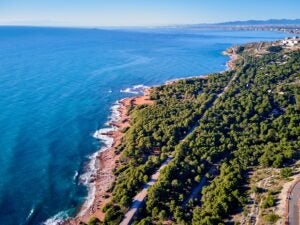Spain’s extensive network of walking paths encourages responsible travel at a slower, more mindful pace.

Travel habits are changing. More tourists are prioritizing greener choices, whether that means opting for a scenic train journey instead of a short flight, staying in eco-friendly hotels or actively choosing activities that support local communities.
Spain is a top destination for eco-conscious travelers. The country is home to the most biosphere reserves in the world, is a global leader on Blue Flag beaches and is working towards protecting 30 percent of its marine areas by 2030. And, with the second-longest high-speed rail network in the world, low-impact travel between Spanish destinations is easier than ever.
One of the best ways to explore Spain responsibly is on foot. Its extensive network of trails, welcoming villages and protected national parks allows travelers to slow down, reduce their environmental impact and connect with local wildlife and communities.
National Parks

Spain’s 16 national parks, four of which are Unesco World Heritage Sites, showcase the country’s extraordinary biodiversity. Many have extensive walking and cycling routes, allowing visitors to explore the country’s most beautiful natural areas with minimal impact to the wildlife and local environment.
Doñana National Park in Andalusia is one of Spain’s most important wetlands, covering roughly 210 square miles across Huelva, Cádiz and Seville. It is home to over 400 bird species and endangered animals such as the Iberian lynx and Spanish imperial eagle.
The national park is a fantastic place to explore the best of Spain on foot, with several well-marked walking trails suitable for all levels. The La Rocina Trail, a 2.3-mile loop starting from the El Rocío Visitor Center, is perfect for birdwatching and takes about an hour to complete. Visitors can learn more about the park’s fragile ecosystem at the park’s visitor center, designated observatories or on guided tours.
The Camino de Santiago

The Camino de Santiago is one of Spain’s most iconic journeys and a rewarding way to travel responsibly through the country’s diverse landscapes. The path winds through local villages, encouraging pilgrims and visitors to support rural communities along the way. Eco-conscious infrastructure has grown in recent years, including eco-albergues (pilgrim hostels) powered by renewable energy, sustainable luggage transfer services and well-maintained walking and cycling trails that minimize erosion.
Several different caminos crisscross Spain, but the most popular is the Camino Francés, stretching about 500 miles from the French border to Santiago de Compostela. The route showcases Spain’s variety of natural landscapes, from the rolling vineyards of La Rioja to the dramatic mountains of León and the lush green countryside of Galicia.
Cattle Migration Paths

For centuries, Spanish shepherds moved their herds between summer and winter pastures along routes known as trashumancia. Many of these historic paths have been restored for hikers and cyclists, offering a slower way to experience the countryside and its rural heritage.
One example of these restored routes is Vereda del Puerto, about two hours west of Madrid, which winds through the Sierra de Gredos. Starting in the village of Candeleda, the trail climbs past farmland and oak and pine forests before opening onto sweeping mountain views, with La Mira peak to the right and Casquerazo to the left.
Greenways

Spain has transformed over 2,000 miles of disused railway lines into Greenways, creating car-free routes for walking and cycling. With around 140 trails across the country, these paths are accessible to all ages and fitness levels. Along the way, former train stations have been repurposed as small hotels, cafés, museums and bike rental hubs, making it easy for travelers to explore comfortably while supporting local economies.
One of the most distinctive Greenways is the Senda del Oso, or Bear Trail, in Asturias. This 31-mile route follows a former mining railway through the Bear Valleys, where conservation efforts help protect the Cantabrian brown bear, one of Europe’s rarest species. Along the trail, walkers and cyclists pass through towns such as Entragu, Proaza and Cueva Huerta, with the chance, if lucky, to spot these remarkable animals in their natural habitat.

Добавить комментарий